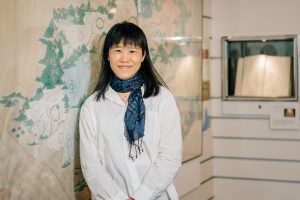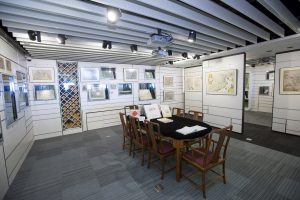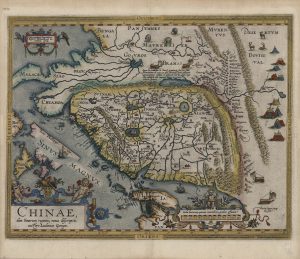
Issue No. 125
September 2022
A New Milestone – HKUST’s Guangzhou Library
The Guangzhou Library of The Hong Kong University of Science and Technology is almost ready  to serve the needs to the new campus. Located in Nansha, the HKUST’s Guangzhou campus will officially open for the fall of 2022. The new Library is just one of the 55 buildings which KPF architects designed for the Guangzhou campus, and the Library will gradually roll out both virtual and physical services to meet the needs of the campus population.
to serve the needs to the new campus. Located in Nansha, the HKUST’s Guangzhou campus will officially open for the fall of 2022. The new Library is just one of the 55 buildings which KPF architects designed for the Guangzhou campus, and the Library will gradually roll out both virtual and physical services to meet the needs of the campus population.
The Guangzhou campus will eventually have 2 library buildings. First is the nearly completed building located in the center of the new campus, with 15,000 square meters of floor space over five levels. This so-called “first phase” library will be student-centric and focus on deep learning environments. This library building will also host the initial Language Learning Center, and a Creative Media production  space.
space.
A second library building currently in the design phase is scheduled for completion in 2023. It will offer some services that match more closely with the Guangzhou campus’ interdisciplinary and innovative engineering education atmosphere – with more open space, more hands-on labs, and physical areas for idea sharing.
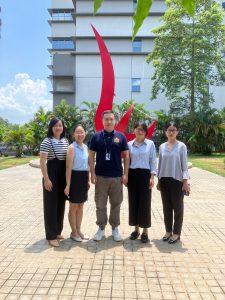 The HKUST Guangzhou Library has received a donation of 50,000 books as a starter collection from HKUST’s Clear Water Bay Library. Over the next five years, we plan for the Guangzhou Library to hold 600,000 printed titles plus 2 million e-books, as well as subscriptions to e-journals and online databases. The Guangzhou Library team is working closely with Clear Water Bay Library staff to ensure the library services carry a similar look and feel for both campus’ users.
The HKUST Guangzhou Library has received a donation of 50,000 books as a starter collection from HKUST’s Clear Water Bay Library. Over the next five years, we plan for the Guangzhou Library to hold 600,000 printed titles plus 2 million e-books, as well as subscriptions to e-journals and online databases. The Guangzhou Library team is working closely with Clear Water Bay Library staff to ensure the library services carry a similar look and feel for both campus’ users. In the campus design, an underground waterway emerges from beneath the Library and runs across the campus. It is a metaphor with the Library being the place where knowledge flow begins. The Guangzhou campus Library will fulfil its mission to bridge the campus as not only a place for knowledge transfer but also as a place for knowledge creation.
In the campus design, an underground waterway emerges from beneath the Library and runs across the campus. It is a metaphor with the Library being the place where knowledge flow begins. The Guangzhou campus Library will fulfil its mission to bridge the campus as not only a place for knowledge transfer but also as a place for knowledge creation.
The birth of the new HKUST Guangzhou Library would not be possible without support from the senior management team and almost every staff at HKUST’s Clear Water Bay Library. Special thanks to Diana Chan and Edward Spodick for providing consultation and corrections with the design firm and construction team from beginning to end!
Change of Library Leadership
Diana Chan – After I left UBC Library to return to HK in 1993, I started as just a part-time librarian here. It was a purposeful decision made due to family commitments to care for the young and the elderly. When a chance came sometime later, I became the Head of the former Reference Department. More opportunities arose over time as I became the Associate Director and finally the Director of the Library in 2012. In my final Strategic Planning Retreat in July, I shared with colleagues the achievements we have made together from 2012-2022. We have achieved our determined goals, rejuvenated our space, strengthened the resources, and demonstrated our values.
Leadership during a paradigm shift is by no means easy. However, I have constantly shared visions with and learned from a team of capable and competent colleagues. Their can-do spirit and execution abilities make my job not hard at all. I am sure Dr. Gabi Wong, the new Director, will feel the same way.
I was scheduled to retire last July but was glad to stay on longer to see through the opening of the Guangzhou Library in September. While I am excited to now be starting a new life chapter, I will also miss this big family, the collegiate spirit, the friendship, the laughter, the fond memories, the scenic view, LG1’s pineapple bun, Passion’s salad, the walking trail…
Gabi Wong – It is a great honour for me to succeed Ms. Diana Chan as the Director upon her retirement. Diana has been my mentor ever since I joined HKUST Library in 1998. As she pointed out, the team of library staff at HKUST has strong collegiate spirit and shared values. This is Diana’s legacy that we cherish dearly. When I came to HKUST, I was a novice librarian. Through the years I grew up professionally and personally in this Library. Now having the opportunity to contribute at this leadership position, I am particularly grateful and excited. I look forward to working with and working for all of you in our broad HKUST community.
Welcome Back – Be Safe and Secure
Please enjoy the facilities and services available. The Library is your learning and social space. Just remember a few things:
- Wear your mask at all times (except when drinking)
- Be considerate of fellow students
- Take a break now and then to stretch or to enjoy the campus and sea views
- If you have questions or suggestions for us, send us a note at library@ust.hk
Health and Safety – Covid is still with us. The Library continues to take actions to help keep you safe:
- Requiring everyone to wear a mask at all times
- Thermal cameras at each entrance
- Public UV-C book sterilizers on G/F, LG3, and LG4
- Hygiene stations at each entrance
- Increased air flow and ventilation
- Increased frequency of cleaning
- Quarterly spraying of public spaces with Germagic® antimicrobial coating
Collection Spotlight: New and Expanded E-Resources
 OED: Oxford English Dictionary – The OED is widely regarded as THE accepted authority on the English language. It is an unsurpassed guide to the meaning, history, and pronunciation of 600,000 words from across the English-speaking world. You can find contemporary meanings as well as the history of individual words.
OED: Oxford English Dictionary – The OED is widely regarded as THE accepted authority on the English language. It is an unsurpassed guide to the meaning, history, and pronunciation of 600,000 words from across the English-speaking world. You can find contemporary meanings as well as the history of individual words.
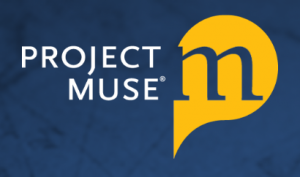 Project Muse – The Standard Collection of Project Muse includes over 380 peer reviewed journals from major University Presses and scholarly societies. Known for its in-depth coverage of humanities and social sciences, it also delivers some science and technology titles.
Project Muse – The Standard Collection of Project Muse includes over 380 peer reviewed journals from major University Presses and scholarly societies. Known for its in-depth coverage of humanities and social sciences, it also delivers some science and technology titles.
![]() 中國期刊全文數據庫 – 經過數年的文獻溯洄展建,中國期刊全文數據庫之九個學科專輯業已覆蓋自1994年以來的期刊內容。
中國期刊全文數據庫 – 經過數年的文獻溯洄展建,中國期刊全文數據庫之九個學科專輯業已覆蓋自1994年以來的期刊內容。
儒學經典庫 – 初集 – 這是儒學經典庫三系列之首,收列清代至民國時期共超過兩千冊的圖文對照善本典籍。
民國時期期刊全文數據庫(1911-1949)- 第12輯 – 第12輯乃上海圖書館最新添加之子集。全套12輯蒐羅國內 自1911年至1949年出版之期刊,數量超過22,000種。
Tech-item Kiosk
The Library continuously plans for more self-service facilities to provide you with more convenience and (in an age of Covid) less human contact. As one of our most popular services, “Technology Items for Loan” will soon have a brand new face. This term, we are launching a large self-service kiosk system where you can borrow technology items.
This Tech-item Kiosk will provide more than 90 compartments for loaning many types of items. These include headphones, adapters, charging cables, HDMI cables, USB drives, card readers, etc. Users with library borrowing privileges can check out items for one day and return them to the Kiosk after use.
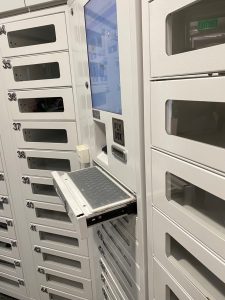 To borrow, simply identify yourself by interacting with the screen. Once you select the item wanted, the door of the assigned compartment will open automatically. You then take the item out and complete the simple check-out process. To return it, just scan the item barcode and put it back to the compartment after the assigned door opens.
To borrow, simply identify yourself by interacting with the screen. Once you select the item wanted, the door of the assigned compartment will open automatically. You then take the item out and complete the simple check-out process. To return it, just scan the item barcode and put it back to the compartment after the assigned door opens.
This is fully self-service – you don’t need to wait for available library staff. Located in the Learning Commons, the Kiosk will run 24/7 during term time. As usual, let us know what you think of this new service and how we can improve it.
Two Library Exhibitions this Fall
Israeli Discoveries and Innovations that Influenced the World – In the G/F Gallery, we are collaborating with the Consulate General of Israel in Hong Kong for an exhibition of Israel’s innovation and invention. Israel is technologically advanced and has many inventions with profound impact on modern civilization. These inventions are very familiar and have greatly improved people’s quality of life. They also contributed to progress in health and medicine, climate and agriculture technology, smart city and mobility, computing and engineering, etc.
The exhibition will illustrate successful stories on creativity in many aspects of Israel, including the origin of an innovative spirit since the founding of the country and Israel’s outstanding performance in technological development. The content of the exhibition covers Israel’s scientific achievements, discoveries and innovations in various fields, earning the State of Israel the nickname “Start-up Nation”. The exhibition will open on September 29 and run through the semester with some activities. Please watch out for more details.
Tartary Exhibition – Selected from the Library’s Special Collections, these unique hand-colored maps and antique books offer different stunning visions of China and Central Asia. They span three hundred years of European cartography (15th to 18th centuries).
When Marco Polo (1254-1324) went to China, he did not have maps to guide him, just the received knowledge of travelers and old tales from antiquity. At that time, the Silk Road was controlled by the Mongols (known in Europe as “Tartars”). Central Asia and Northern China (Cathay) were therefore known as “Tartary”.
When the first Portuguese travelers came to Southern China by sea in the 1520s, they followed Marco Polo in calling it “Mangi”. It took the Europeans two more generations to establish that “Mangi” and “Cathay” referred to just one country: “China”. It took them even longer to draw maps that resembled China’s real shape and reflected its native names.
In the 1700s, European cartographers finally stopped using the term “Tartary”. This happened when the Kangxi Emperor (reigned 1661-1722) ordered a detailed survey of his empire, helped by Jesuit scientists. These Jesuits covertly sent the resulting maps back to Europe, resulting in a large Atlas of “Greater China”. Thus, the “modern” era of western mapping of China was born.
Writing a DMP – Vital to Research
Research Data Management Planning is a vital part of reproducible research. The traceability and reusability of research data underlying publications is a key indicator of research reproducibility, and thus integrity. As a result, more and more researchers are expected to actively manage their research data or have already been required by funders to include their data management practices through a formal document called Data Management Plan (DMP) as part of their grant applications.
DMP aims to outline how research data will be generated, collected, described, shared, and preserved. The process of constructing a DMP helps researchers think early about various aspects of data management and clarify needed budget and resources. In other words, the planning itself is an indispensable part of research.
Putting together a DMP can be a daunting task for researchers, as each research project is highly diverse and individual. To help you meet the challenge, HKUST Library has been offering postgraduate open workshops on research data management and data management plan writing . We also encourage you to use DMPTool@HKUST (https://dmptool.hkust.edu.hk/), an online DMP writing platform, to create your plan.
 The DMP template hosted on DMPTool@HKUST guides you in addressing six major areas: nature of data, ethics and rights, data sharing, file management and storage, deposit and preservation, and resources planning. A plan is only useful when it is easy to understand and actionable, so we have included guidelines and sample answers for easy reference and adaption. As a “living” document, DMPs hosted on the platform can be updated by plan collaborators at any time. At the end of a research project, a DMP then becomes a good reference for data sharing decisions and research reproducibility options.
The DMP template hosted on DMPTool@HKUST guides you in addressing six major areas: nature of data, ethics and rights, data sharing, file management and storage, deposit and preservation, and resources planning. A plan is only useful when it is easy to understand and actionable, so we have included guidelines and sample answers for easy reference and adaption. As a “living” document, DMPs hosted on the platform can be updated by plan collaborators at any time. At the end of a research project, a DMP then becomes a good reference for data sharing decisions and research reproducibility options.
HKUST Library Book Launch!
The HKUST Library has a unique collection of historical maps that document the development of Western trade and diplomatic relationships with China. Thanks to the generous contributions by Dr. Ko Pui Shuen, the collection has been digitized and enlarged – and most recently Dr. Ko has sponsored the writing of a scholarly book about early Western maps of China printed in Europe. This book will feature maps from the HKUST Library’s Special Collections as well as rare and unique maps from other major Asian, European, and American map collections.
Titled Regnum Chinae: The Printed Western Maps of China to 1735, the book is authored by the head of our Special Collections, Dr. Marco Caboara. It has taken him four years to complete, under the guidance of the foremost Dutch experts of historical cartography.
It reproduces and describes, for the first time, all the maps of China printed in Europe between 1584 and 1735, unravelling the origin of each individual map, their different printing, issues and publication dates. The book also tells, for each map, the unique story that made possible these visions from another world, stories marked by scholarly breakthroughs, obsession, missionary zeal, commercial sagacity, and greed.
The most authoritative scholars of Chinese cartography, both Western and Chinese, have contributed chapters to the introduction, the first systematic coverage of this field in any language. The book will be published by the Dutch academic publisher Brill at the end of September 2022 (https://brill.com/view/title/39120). It is accompanied by a website addressed to researchers, collectors, scholars, and anyone with curiosity for maps, history and geography, giving access to all the 127 maps described in the book, and it allows access to high-definition images of all the maps.
The book will be formally launched on October 13 in the presence of Dr. Ko and President Wei.
New Library Logo!
We are excited to announce that the Library has a new logo, approved by the University in July. Commissioned by the Library and designed by HKUST’s Media Technology and Publishing Center, the logo features the distinctive window wall of the HKUST Library, as viewed from both inside and outside. This new logo embodies the Library’s role as a gateway or window to the world: with the light of knowledge and insight pouring in and shining out.
The base, “LiB”, shows a solid foundation upon which wisdom and creativity are built. The center red spot references the Sundial and the spirit of HKUST. The rich-color design also reflects the Library’s core values for diversity and excellence.
Orientation 2022: Face-to-Face, Plus Zoom and PRIZES!
The Library is pleased to be able to restore face-to-face orientation activities, along with Zoom sessions. For the first time since fall 2019 we will offer face-to-face orientation sessions. But, since some students may prefer online workshops, we offer those too.
For Undergraduates (UGs), we offer 26 one-hour sessions starting from August 22. Half face-to-face, and half online via Zoom. Face-to-face participants will meet in the G/F Gallery and then have a briefing session and walking tour. To encourage students to come into the Library for the briefing and tour, we will have Q&A via Menti and the top scorer for each tour will win a prize.
For Post graduates (PGs), we offer 32 sessions (75 minutes) starting from August 29. Face-to-face participants meet in the G/F Gallery and have a walking tour followed by a briefing in the LG4 Multifunction Room.
For both UGs and PGs, Zoom sessions will be supplemented by self-learning with the Library’s 360-degree Virtual Tour: https://lbcone.ust.hk/eobj/vt/index.htm
All new and existing students will be eligible to take part in an online quiz “How Well Do You Know the Library”. The top scorers can join a lucky draw to win a library prize.
last modified 02 September 2022




